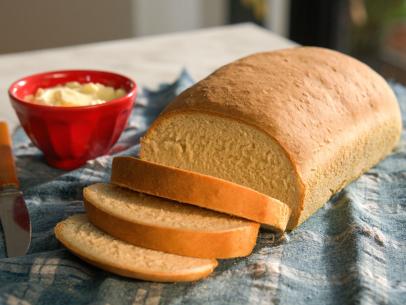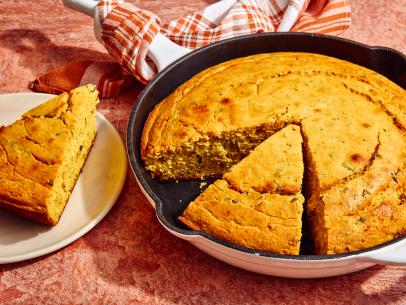
Recipe courtesy of
Andy Liang
for
Food Network Kitchen
Recipe courtesy of
Andy Liang
for
Food Network Kitchen
Watch how to make this recipe.
Chinese Milk Bread
Getting reviews...
- Level: Intermediate
- Total: 3 hr 40 min (includes rising and cooling times)
- Active: 1 hr
- Yield: 8 buns
-
- Nutritional Analysis
- Per Serving
- Serving Size
- 1 of 8 servings
- Calories
- 259
- Total Fat
- 10 g
- Saturated Fat
- 5 g
- Carbohydrates
- 36 g
- Dietary Fiber
- 1 g
- Sugar
- 9 g
- Protein
- 7 g
- Cholesterol
- 68 mg
- Sodium
- 182 mg
Chinese milk bread has a soft, fluffy interior and sweet, golden-brown top. One bite and the tender crumb melts in your mouth. Chinese milk bread is very similar to Japanese milk bread (called “shokupan”) in that a mixture of flour and water is heated then cooled before adding to the dough. This tangzhong method used here has a higher ratio of water to flour, which helps the bread retain more moisture and remain softer for longer. You can bake the dough in a loaf pan to slice for sandwiches or toast. Here, we shape the dough into individual buns. They can be enjoyed on their own, with butter and jam, or used as slider buns.
- Level: Intermediate
- Total: 3 hr 40 min (includes rising and cooling times)
- Active: 1 hr
- Yield: 8 buns
-
- Nutritional Analysis
- Per Serving
- Serving Size
- 1 of 8 servings
- Calories
- 259
- Total Fat
- 10 g
- Saturated Fat
- 5 g
- Carbohydrates
- 36 g
- Dietary Fiber
- 1 g
- Sugar
- 9 g
- Protein
- 7 g
- Cholesterol
- 68 mg
- Sodium
- 182 mg
Ingredients
Directions
- Whisk the 2 tablespoons (18 g) bread flour with 1/2 cup cold water in a medium saucepan until no lumps remain. Cook, whisking constantly over medium heat until thickened and opaque, about 2 minutes. Transfer to a stand mixer bowl and let cool slightly. Add the 1/2 cup milk and whisk by hand until the mixture is broken up in small pieces. Whisk in the yeast and 1 tablespoon of the sugar. Let sit until foamy on the surface, about 5 minutes.
- Meanwhile, grease a large bowl with 1/2 tablespoon of the butter and set aside. Grease a 9-inch nonstick springform or cake pan with 3-inch-high sides using another 1/2 tablespoon of the butter and set aside.
- Top the yeast mixture with the following ingredients in this order: 1 of the eggs, the dry milk powder, remaining 2 cups (240 g) bread flour, the cake flour, 3 tablespoons of the sugar and the salt. Fit the stand mixer with a dough hook and mix on low speed until all the flour is moistened. Increase the speed to medium and mix until the dough is smooth and passes the window pane test, about 10 minutes (see Cook’s Note); scrape down the bowl halfway through. Mix in 1 tablespoon of the remaining butter on medium-low speed until absorbed. Repeat, adding 1 tablespoon of the remaining butter at a time, and mix after each addition until the dough is smooth, about 6 minutes.
- Transfer the dough to a lightly floured surface and form into a tight ball by pulling the edges of the dough toward the center. Toss in the prepared bowl to coat with butter, cover with plastic wrap and let rise in a warm, draft-free area until doubled in size, about 1 hour. Reserve plastic wrap.
- Transfer the dough to a lightly floured surface and flatten to deflate it. Divide into 8 equal pieces, each about 90 g. Flatten 1 piece into a 3-inch disk and gather all the edges to meet at the center. Flip over and roll into a ball on a work surface, cupping the top of the dough with one hand, until the ball is completely smooth. Repeat with the remaining pieces and transfer all the balls to the prepared pan. Cover with the reserved plastic wrap and let rise until puffy and the buns completely cover the bottom of the pan, about 35 minutes.
- Position an oven rack in the upper third of the oven and preheat to 350 degrees F.
- Whisk together the remaining egg with the remaining 1 tablespoon milk in a small bowl until no streaks of egg white remain and set aside. Brush onto each bun. Bake until the tops are golden brown, 25 to 30 minutes.
- Meanwhile, mix the hot water with the remaining 2 teaspoons sugar in a small bowl until the sugar is slightly dissolved. Brush onto the tops of the buns when they’re done baking and let cool for 5 minutes.
- Run a thin knife around the pan, release the buns from the springform or cake pan and let cool on a wire rack until still slightly warm. Enjoy the soft and sweet buns.
- The buns can be stored in an airtight container at room temperature for about 5 days or tightly wrapped and frozen for up to 1 month.
Cook’s Note
For the window pane test, slowly pull off a small piece of dough. If you can stretch it into a thin film without breaking until your finger is visible on the other side, it passes the test. If it does break, knead the dough on medium speed for another 2 minutes and test again.






























